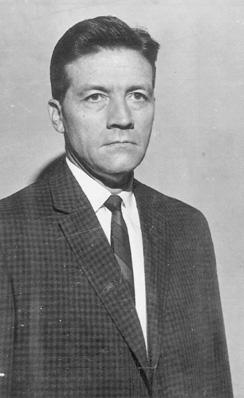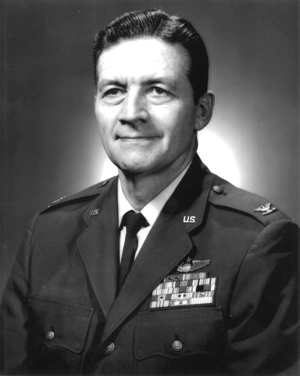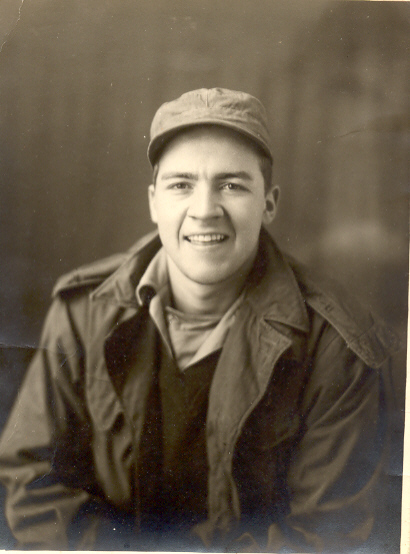<Back to Index>
- Colonel of the U.S. Air Force and Military Strategist John Richard Boyd, 1927
PAGE SPONSOR



Colonel John (Richard) Boyd (January 23, 1927 – March 9, 1997) was a United States Air Force fighter pilot and Pentagon consultant of the late 20th century, whose theories have been highly influential in the military, sports and business.
Boyd was born on January 23, 1927 in Erie, Pennsylvania. He graduated from the University of Iowa with a Bachelor's degree in economics and, after an extended period as a fighter pilot, from Georgia Tech with a Bachelor's degree in industrial engineering.
As a high school graduate, Boyd enlisted in the United States Army and served in the Army Air Forces from 1945 to 1947, assigned as a swimming instructor in occupied Japan. After graduating from the University of Iowa, he served as a U.S. Air Force officer from July 8, 1951, until his retirement on August 31, 1975. He was dubbed "Forty Second Boyd" for his standing bet as an instructor pilot that beginning from a position of disadvantage, he could defeat any opposing pilot in air combat maneuvering in less than forty seconds. According to his biographer, Robert Coram, Boyd was also known at different points of his career as "The Mad Major" for the intensity of his passions, as "Genghis John" for his confrontational style of interpersonal discussion, and as the "Ghetto Colonel" for his spartan lifestyle.
Boyd died of cancer in Florida on March 9, 1997 at age 70. He was buried with full military honors at Arlington National Cemetery on March 20, 1997.
During the early 1960s, Boyd, together with Thomas Christie, a civilian mathematician, created the Energy - Maneuverability, or E-M, theory of aerial combat. A legendary maverick by reputation, Boyd was said to have "stolen" the computer time to do the millions of calculations necessary to prove the theory, but it became the world standard for the design of fighter planes. At a time when the Air Force's FX project (subsequently the F-15) was foundering, Boyd's deployment orders to Vietnam were canceled and he was brought to the Pentagon to re-do the trade off studies according to E-M. His work helped save the project from being a costly dud, even though its final product was larger and heavier than he desired. However, cancellation of that tour in Vietnam meant that Boyd would be one of the most important air - to - air combat strategists with no combat kills. He had only flown a few missions in the last months of the Korean War, and all of them as a wingman.
With Colonel Everest Riccioni and Pierre Sprey, Boyd formed a small advocacy group within Headquarters USAF which dubbed itself the "Fighter Mafia". Riccioni was an Air Force fighter pilot assigned to a staff position in Research and Development, while Sprey was a civilian statistician working in Systems Analysis. Together, they were the visionaries who conceived the LFX Lightweight Fighter program, which ultimately produced both the F-16 and F/A-18 Hornet, the latter a development of the YF-17 Light Weight Fighter. Boyd's acolytes were also largely responsible for developing the Republic A-10 Thunderbolt II or "Warthog" ground - support aircraft, though Boyd himself had little sympathy of the "air - to - mud" assignment.
After his retirement from the Air Force in 1975, Boyd continued to work at the Pentagon as a consultant in the Tactical Air office of the Office of the Assistant Secretary of Defense for Program Analysis and Evaluation.
Boyd is credited for largely developing the strategy for the invasion of Iraq in the first Gulf War. In 1981 Boyd had presented his briefing, Patterns of Conflict, to Richard Cheney, then a member of the United States House of Representatives. By 1990 Boyd had moved to Florida because of declining health, but Cheney (then the Secretary of Defense in the George H. W. Bush administration) called him back to work on the plans for Operation Desert Storm. Boyd had substantial influence on the ultimate "left hook" design of the plan.
In a letter to the editor of Inside the Pentagon, former Commandant of the Marine Corps General Charles C. Krulak is
quoted as saying "The Iraqi army collapsed morally and intellectually
under the onslaught of American and Coalition forces. John Boyd was an
architect of that victory as surely as if he'd commanded a fighter wing or a maneuver division in the desert."
Boyd's key concept was that of the decision cycle or OODA Loop, the process by which an entity (either an individual or an organization) reacts to an event. According to this idea, the key to victory is to be able to create situations wherein one can make appropriate decisions more quickly than one's opponent. The construct was originally a theory of achieving success in air - to - air combat, developed out of Boyd's Energy - Maneuverability theory and his observations on air combat between MiGs and F-86s in Korea. Harry Hillaker (chief designer of the F-16) said of the OODA theory, "Time is the dominant parameter. The pilot who goes through the OODA cycle in the shortest time prevails because his opponent is caught responding to situations that have already changed."
Boyd hypothesized that all intelligent organisms and organizations undergo a continuous cycle of interaction with their environment. Boyd breaks this cycle down to four interrelated and overlapping processes through which one cycles continuously:
- Observation: the collection of data by means of the senses
- Orientation: the analysis and synthesis of data to form one's current mental perspective
- Decision: the determination of a course of action based on one's current mental perspective
- Action: the physical playing - out of decisions
Of course, while this is taking place, the situation may be changing. It is sometimes necessary to cancel a planned action in order to meet the changes.
This decision cycle is thus known as the OODA loop. Boyd emphasized that this decision cycle is the central mechanism enabling adaptation (apart from natural selection) and is therefore critical to survival.
Boyd theorized that large organizations such as corporations, governments, or militaries possessed a hierarchy of OODA loops at tactical, grand - tactical (operational art), and strategic levels. In addition, he stated that most effective organizations have a highly decentralized chain of command that utilizes objective - driven orders, or directive control, rather than method - driven orders in order to harness the mental capacity and creative abilities of individual commanders at each level. In 2003, this power to the edge concept took the form of a DOD publication "Power to the Edge: Command... Control... in the Information Age" by Dr. David S. Alberts and Richard E. Hayes. Boyd argued that such a structure creates a flexible "organic whole" that is quicker to adapt to rapidly changing situations. He noted, however, that any such highly decentralized organization would necessitate a high degree of mutual trust and a common outlook that came from prior shared experiences. Headquarters needs to know that the troops are perfectly capable of forming a good plan for taking a specific objective, and the troops need to know that Headquarters does not direct them to achieve certain objectives without good reason.
In 2007, strategy writer Robert Greene discussed the loop in a post called "OODA and You". He
insisted that it was "deeply relevant to any kind of competitive
environment: business, politics, sports, even the struggle of organisms
to survive", and claimed to have been initially "struck by its
brilliance".
Boyd never wrote a book on military strategy. The central works encompassing his theories on warfare consist of a several hundred slide presentation entitled Discourse on Winning & Losing and a short essay entitled "Destruction & Creation" (1976).
In Destruction & Creation, Boyd attempts to provide a philosophical foundation for his theories on warfare. In it he integrates Gödel's Incompleteness Theorem, Heisenberg's Uncertainty Principle and the Second Law of Thermodynamics to provide a context and rationale for the development of the OODA Loop.
Boyd inferred the following from each of these theories:
- Gödel's Incompleteness Theorem: any logical model of reality is incomplete (and possibly inconsistent) and must be continuously refined / adapted in the face of new observations.
- Heisenberg's Uncertainty Principle: there is a limit on our ability to observe reality with precision.
- Second Law of Thermodynamics: The entropy of any closed system always tends to increase, and thus the nature of any given system is continuously changing even as efforts are directed toward maintaining it in its original form.
From
this set of considerations, Boyd concluded that to maintain an accurate
or effective grasp of reality one must undergo a continuous cycle of
interaction with the environment geared to assessing its constant
changes. Boyd, though he was hardly the first to do so, then expanded Darwin's theory of evolution,
suggesting that natural selection applies not only in biological but
also in social contexts (such as the survival of nations during war or
businesses in free market competition). Integrating these two concepts,
he stated that the decision cycle was the central mechanism of
adaptation (in a social context) and that increasing one's own rate and
accuracy of assessment vis-a-vis one's counterpart's rate and accuracy
of assessment provides a substantial advantage in war or other forms of
competition. The key to survival and autonomy is the ability to adapt to
change, not perfect adaptation to existing circumstances. Indeed, Boyd
noted that radical uncertainty is a necessary precondition of physical
and mental vitality: all new opportunities and ideas spring from some
mismatch between reality and ideas about it, as examples from the
history of science, engineering and business illustrate.
Boyd divided warfare into three distinct elements:
- Moral Warfare: the destruction of the enemy's will to win, disruption of alliances (or potential allies) and induction of internal fragmentation. Ideally resulting in the "dissolution of the moral bonds that permit an organic whole [organization] to exist." (i.e., breaking down the mutual trust and common outlook mentioned in the paragraph above.)
- Mental Warfare: the distortion of the enemy's perception of reality through disinformation, ambiguous posturing, and / or severing of the communication / information infrastructure.
- Physical Warfare: the abilities of physical resources such as weapons, people and logistical assets.
John Boyd's briefing Patterns of Conflict provided the theoretical foundation for the "defense reform movement" (DRM) in the 1970s and 1980s. Other prominent members of this movement included Pierre Sprey, Franklin 'Chuck' Spinney, William Lind, Assistant Secretary of Defense for Operational Testing and Evaluation Thomas Christie, Congressman Newt Gingrich, and Senator Gary Hart. The Military Reform movement fought against what they believed were unnecessarily complex and expensive weapons systems, an officer corps focused on the careerist standard, and over-reliance on attrition warfare. Another reformer, James G. Burton, disputed the Army test of the safety of the Bradley fighting vehicle. James Fallows contributed to the debate with an article in The Atlantic Monthly titled "Muscle - Bound Superpower", and a book, National Defense. Today, younger reformers continue to use Boyd's work as a foundation for evolving theories on strategy, management and leadership.
Boyd gave testimony to Congress about the status of military reform after Operation Desert Storm.
In January 1980 Boyd gave his briefing Patterns of Conflict at the Marines AWS (Amphibious Warfare School). This led to the instructor at the time, Michael Wyly, and Boyd changing the curriculum, with the blessing of General Trainor. Trainor later asked Wyly to write a new tactics manual for the Marines. John Schmitt, guided by General Alfred M. Gray, Jr. wrote Warfighting, during the writing he collaborated with John Boyd. Wyly, Lind, and a few other junior officers are credited with developing concepts for what would become the Marine model of maneuver warfare.
Wyly, along with Pierre Sprey, Ray Leopold, Franklin 'Chuck' Spinney, Jim Burton, and Tom Christie were described by writer Coram as Boyd's Acolytes, a group who, in various ways and forms, promoted and disseminated Boyd's ideas throughout the modern military and defense establishment.